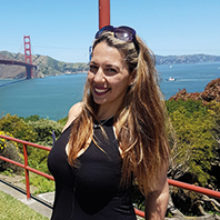Membership Q&A
Issue: Microbiology in Popular Culture
07 November 2017 article

This is a regular column to introduce our members. In this issue, we’re pleased to introduce Mayri (Ale) Diaz De Rienzo.
Where are you currently based?
Liverpool John Moores University as a Lecturer in Biotechnology.
What is your area of specialism?
Applied microbiology and biotechnology. The production of biosurfactants to use as antimicrobial agents.
And more specifically?
Fermentation and downstream processing of biosurfactants, and their use in the disruption/killing of biofilms as well as planktonic cells.
Tell us about your education to date.
I obtained my BSc in Cell Biology from the Central University of Venezuela in Caracas, Venezuela. After that I worked as a researcher assistant in a fermentative process lab at the same university until March 2006, when I started my PhD (funded by FONACYT) in Cell Biology at the Central University of Venezuela. After two years there I did a placement in 2008 at the National Autonomous University of Mexico at the Biomedicas Institute, followed by a second placement at the Complutense University of Madrid (2009) in the bio-hydrometallurgy department with the aim of finishing there. By 2010 I got the degree certified by both universities: Central University of Venezuela and Complutense University of Madrid. In early 2011 I started my first postdoc position at Professor Ibrahim Banat’s lab at the University of Ulster in Northern Ireland, and then, in early 2014, I moved to the University of Manchester to do my second postdoc in the lab of Dr Peter Martin until August 2017. I am now at Liverpool John Moores University.
Where did your interest in microbiology come from?
Venezuela is one of the main oil producers in the world. From when I started my degree in biology I knew I would like to work in a field where I could integrate oil production and microbiology from a bioremediation point of view. I did my final dissertation in the characterisation of metabolites that could be used in petrochemical processes, and from there I have been working with biosurfactants in a wide range of applications.
What are the professional challenges that present themselves, and how do you try to overcome them?
I’d say that the main challenge is keeping up with science, as everything changes so fast. The best ways to overcome this is establishing wide and strong collaborations where contributions can happen more quickly and effectively.
What is the best part about ‘doing science’?
Going out there and talking passionately about what I do! And no less important is the networking; I have made amazing friends at each event I have attended.
Who is your role model?
I admire George O’Toole for all his contributions to the biofilm world! But there is no bigger role model than my mother.
What do you do to relax?
I’m not sure if relax is the right word, but in my spare time I go to the gym regularly, and I run, swim, and hike! In 2015, I took part in the Manchester Sport Awards and the Great Manchester Sports Awards in the Life Change Category.
What one record and luxury item would you take to a desert island?
This is a hard one! A record I think would be Let Her Go by Passenger, and the item would be a very thick duvet that I could use in different ways!
Tell us one thing that your work colleagues won’t know about you.
In June 2013 I injured my spine and, as a result, I had two surgical operations on my back and couldn’t move my legs for over six months. I went from lying down for 24 hours a day in a bed to a wheelchair, then crutches, and now I feel it is mandatory to run 10K in each new city that I visit!
If you weren’t a scientist, what would you be?
A doctor. I’d be a cardiologist.
If you would like to be featured in this section or know someone who may, contact Paul Easton, Head of Membership Services, at [email protected]
Image: M. Diaz De Rienzo.
